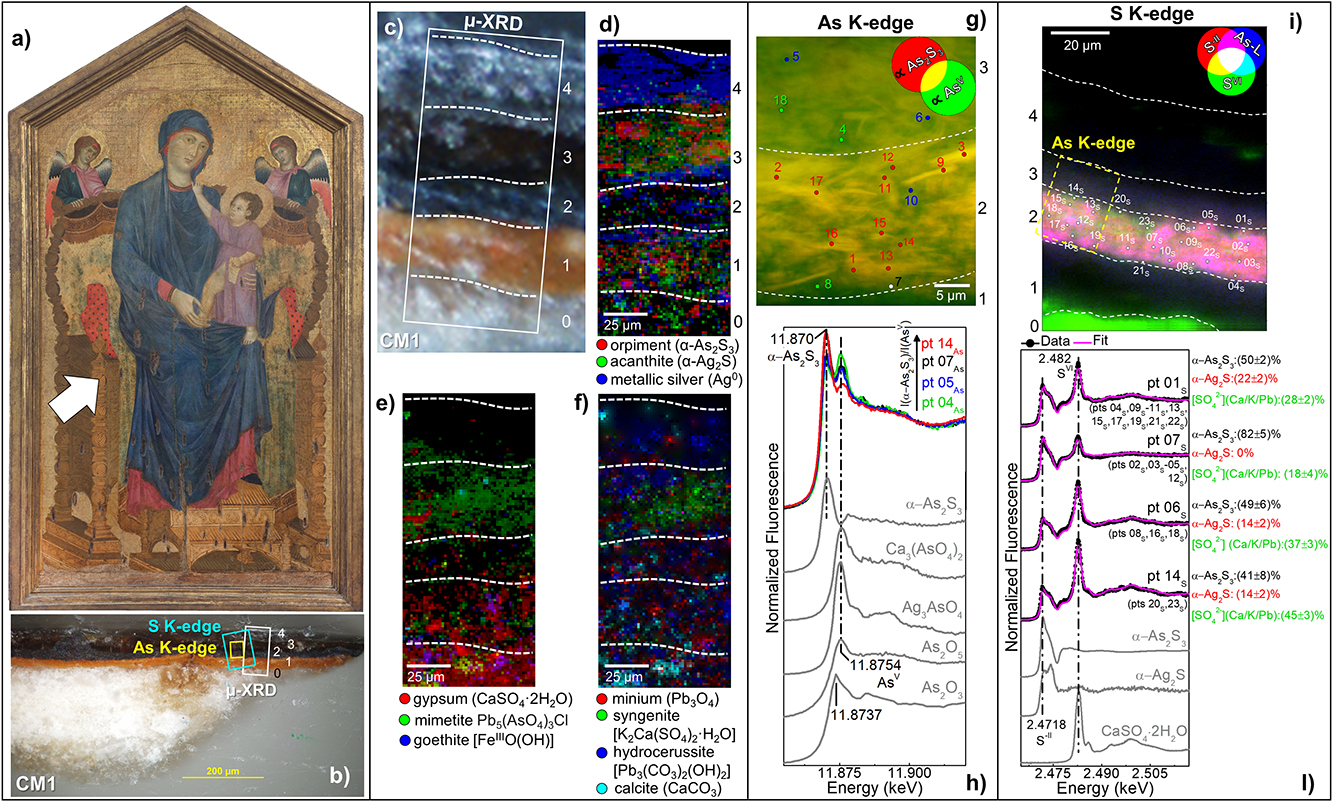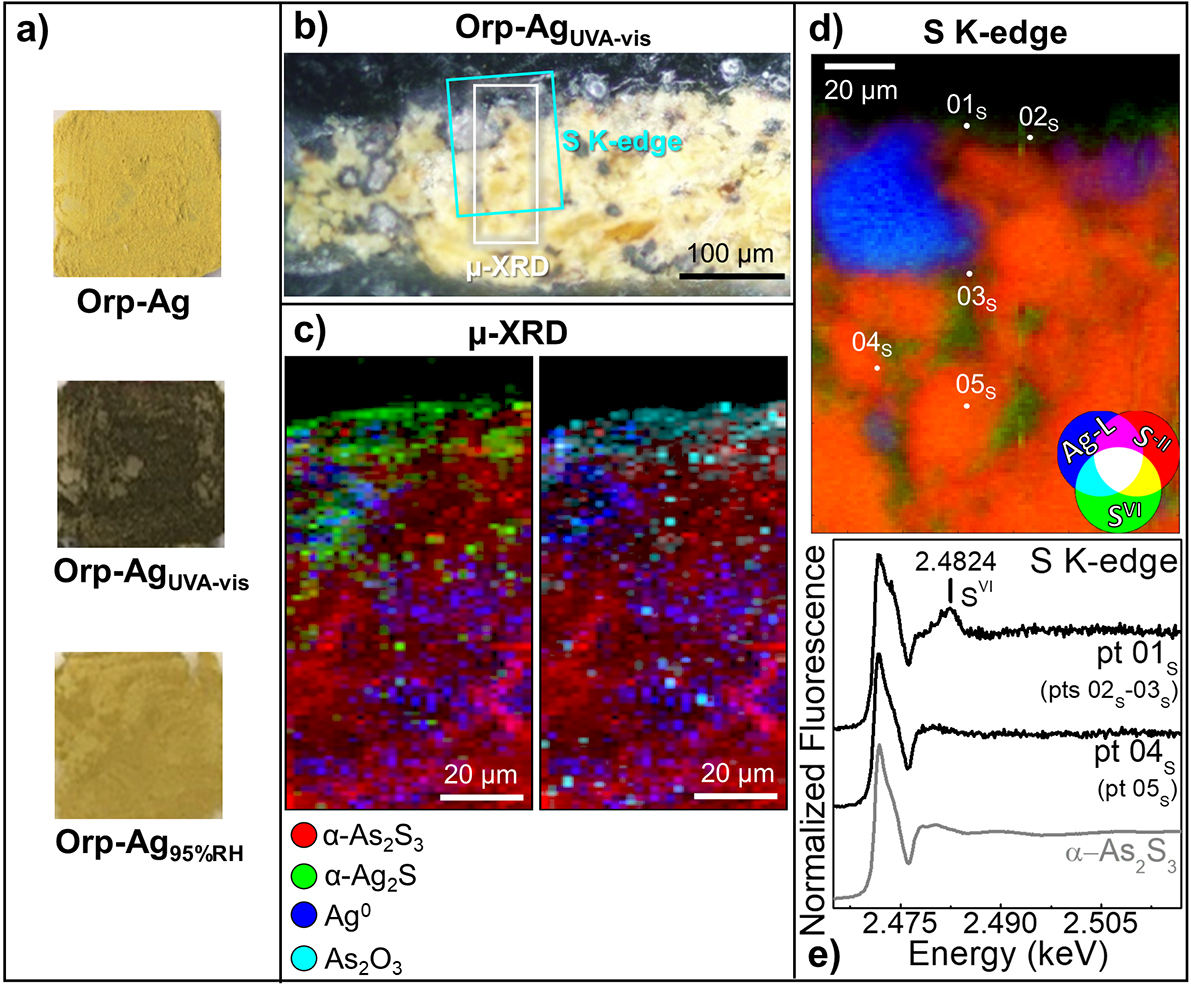- Home
- News
- Spotlight on Science
- Revealing the causes...
Revealing the causes of darkening of “fake-gold” decorations on medieval paintings
16-12-2021
A combination of X-ray micro-analytical techniques performed at ID21 and ID16B at the ESRF and at PETRA III-DESY (Hamburg) shows that light and humidity are triggering factors for the darkening of “fake-gold” decorations in the thirteenth-century painting Maestà by Cimabue. The findings may help better preserve this masterpiece.
Share
Gilded paintings were greatly appreciated by Masters of late medieval Italian art, but the high cost of real gold restricted its widespread use. The Italian painter Cimabue used a mixture made up of the yellow pigment orpiment (As2S3) and metallic silver (Ag0) powder to create a similar golden hue in some of his works of art, including the Maestà (Church of Santa Maria dei Servi, Bologna, Italy) (Figure 1a) [1]. Nevertheless, the “fake-gilded” areas of the painting were not as enduring as real gold and nowadays appear considerably darker than originally intended.
In a recent collaborative work, researchers from the CNR, the University of Bologna and the University of Perugia in Italy, and the University of Antwerp in Belgium investigated the causes of darkening of “fake-gilded” decorations in the Maestà using a combination of synchrotron radiation X-ray micro-analytical techniques and vibrational micro-spectroscopy methods. Micro X-ray fluorescence (µ-XRF) and micro X-ray absorption near edge structure (µ-XANES) spectroscopy measurements at S K-, Ag L3- and As K-edges of a minute sample, obtained by scraping off a spot of darkened decoration (Figure 1b), were performed at beamlines ID21 and ID16B, while micro X-ray diffraction (µ-XRD) mapping investigations were carried out at the German synchrotron PETRA III-DESY in Hamburg.

Fig. 1: a) Photograph of Maestà of Santa Maria dei Servi (tempera and gold on panel painting, ca. 1280-1285; Bologna, Italy) by Cimabue; the white arrow shows the sampling area. b) Micrograph of cross-section CM1 and (c) corresponding detail image where µ-XRD mapping was performed. d-f) Composite µ-XRD images of the identified crystalline phases. Composite μ-XRF images of (g) AsIII (∝α-As2S3) (red) and AsV (green) and i) S−II/SVI/As-L. Selection of the μ-XANES spectra (black) recorded at (h) As K-edge and (l) S K-edge from the spots shown in (g) and (i) compared to those of a set of As-/S-reference compounds (grey). In (b), the rectangles show the areas where X-ray investigations were performed, while numbers indicate the paint stratigraphy.
The high specificity, sensitivity and lateral resolution of the employed X-ray analytical methods made it possible to provide the first evidence of the nature and distribution of the degradation products of the “fake-gilded” decorations in the Maestà. In the original “fake-gilded” layers (n. 2 and 3), µ-XRD mapping combined with As K- and Ag L3-edge μ-XANES spectroscopy revealed the presence of black acanthite (α-Ag2S) as a secondary product of the original Ag0 powder (Figure 1c,d). In the innermost darkened gilding layer (n. 2), and in the outermost α-As2S3-free repaint layer (n. 4), Ag0 was still present. The detection of α-Ag2S mainly in the uppermost original gilded layer (n. 3) and in the As2S3-containing layers of the Maestà (n. 2 and 3) suggests that sulfides (S-II) arising from the degradation of orpiment might be the main source for the formation of achantite.
Interestingly, next to α-As2S3, variable abundances of arsenates (AsV) and sulfates (SVI) were also found in layers 2-3 (Figure 1e-l). µ-XRD identified such species as mimetite [Pb5(AsO4)3Cl], a yellowish lead arsenate-based rare mineral, and syngenite [K2Ca(SO4)2·H2O] (Figure 1e,f). It is likely that both compounds were not originally present but resulted from the reaction between the oxidation products of orpiment and other components that are widespread within the paint, including Cl--ions and Pb2+-ions released by lead-based pigments (such as minium and lead white), or K+ and Ca2+ cations. Based on the fact that in layer 4 no As-compounds are present, it is reasonable to hypothesise that the layer 4, rich in lead white and Ag0, is likely to have been applied on top of the other paint layers after the oxidation of Ag0 and α-As2S3 took place in layer 3, possibly to counterbalance or completely cover the darkening of the “fake-gilded” surface.

Fig. 2: a) Photographs of the paint mock-ups obtained by mixing orpiment and metallic silver before (Orp-Ag) and after exposure to UVA-visible light (Orp-AgUVA-vis) and high moisture conditions (Orp-Ag95%RH). b) Photomicrograph of Orp-AgUVA-vis cross-section. c) Composite µ-XRD images of α-As2S3 (red), α-Ag2S (green), Ag0 (blue) and As2O3 (cyan). d) RGB µ-XRF maps of S-II/SVI/Ag-L and (e) selection of S K-edge µ-XANES spectra (black) acquired from the spots shown in (d). In (b), rectangles show the areas where maps of (c,d) were recorded.
To evaluate the effects of metallic silver and of different environmental parameters on the degradation of orpiment, and thus to provide direct insights into which factors are responsible for the darkening of the “fake-gilded” decorations of the Maestà, the study of the painting was integrated with that of a set of tempera paint mock-ups prepared using commercial powders of orpiment, metallic silver and mixtures of orpiment and metallic silver. The mock-ups were subjected to accelerated aging under controlled conditions of light and humidity (Figure 2a). Overall, X-ray investigations of these samples (Figure 2b-e) established that: (i) Ag0 and moisture are key factors in triggering the transformation of As2S3 to α-Ag2S and As oxides; (ii) sulfides arising from the degradation of As2S3 are mainly responsible for the formation of α-Ag2S; (iii) light exposure strengthens the tendency of the paint components towards degradation by favouring the formation of sulfates.
The outcomes of this study are expected to have implications for the preventive conservation of the Maestà by Cimabue and of several other Old Master paintings created with a similar technique. To mitigate further degradation of “fake-gold” areas, the masterpiece should not be exposed to excessively high moisture levels (i.e., RH < 30%), whereas lighting conditions should be kept at standard values foreseen for light-sensitive painting materials.
Principal publication and authors
Development of a multi-method analytical approach based on the combination of synchrotron radiation X-ray micro-analytical techniques and vibrational micro-spectroscopy methods to unveil the causes and mechanism of darkening of “fake-gilded” decorations in a Cimabue painting, L. Monico (a,b,c), S. Prati (d), G. Sciutto (d), E. Catelli (d), A. Romani (a,b), D. Quintero Balbas (d), Z. Li (d), S. De Meyer (c), G. Nuyts (c), K. Janssens (c,g), M. Cotte (e,f), J. Garrevoet (h), G. Falkenberg (h), V.I. Tardillo Suarez (e), R. Tucoulou (e), R. Mazzeo (d), J. Anal. At. Spectrom (2021); https://doi.org/10.1039/D1JA00271F
(a) CNR-SCITEC, Perugia (Italy)
(b) SMAArt Centre, Department of Chemistry, Biology, and Biotechnology, University of Perugia (Italy)
(c) AXIS Research Group, NANOlab Centre of Excellence, University of Antwerp (Belgium)
(d) Microchemistry and Microscopy Art Diagnostic Laboratory (M2ADL), Department of Chemistry “G. Ciamician”, University of Bologna – Ravenna (Italy)
(e) ESRF
(f) LAMS, CNRS UMR 8220, Sorbonne Université, Paris (France)
(g) Rijksmuseum, Conservation & Restoration – Scientific Research, Amsterdam (Netherlands)
(h) DESY, Hamburg (Germany)
References
[1] G. Sciutto et al., Microchem. J. 137, 277 (2018).



